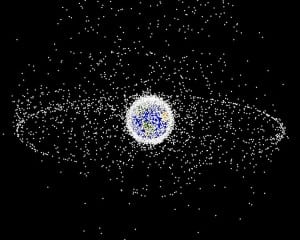Latest News

Rendering of projected orbital debris in two primary fields: the ring of objects in geosynchronous orbit (GEO) and the cloud of objects in low Earth orbit (LEO). Photo: Wikimedia Commons
[Via Satellite 05-27-2014] The University of Maryland (UMD) created a Center for Orbital Debris Education and Research (CODER) for addressing issues in orbital space debris, which often pose a threat to space-based communications, weather forecasting, Earth observation, among other services.
Over 22,000 pieces of space “junk”, particles amounting to 3.9 inches or larger, are tracked in the Earth’s orbit. However, it is believed that there is a larger expanse of smaller debris that cannot be tracked with current capabilities.
“The goal of the center is to raise awareness and financial support, help to coordinate, conduct and establish collaborative research and ultimately to provide new funding streams to accelerate these efforts,” said Associate Professor of Aerospace Engineering Raymond Sedwick, one of the founding faculty members. “The University of Maryland is well-positioned to take the lead in creating a multi-disciplinary, multi-organizational, collaborative research center that will pursue orbital debris solutions through research in new technologies, policies and economic solutions.”
Get the latest Via Satellite news!
Subscribe Now